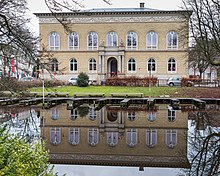Augusteum (Oldenburg)
The Augusteum in Oldenburg , completed in 1867, is one of the first museum buildings in northern Germany. As the location of the “Old Masters Gallery” of the State Museum for Art and Cultural History Oldenburg , masterpieces of Dutch, Italian, German and French painting from the 15th to 18th centuries can be seen here at Elisabethstraße 1.
building
The origin of the Augusteum goes back to a foundation of the Oldenburg Grand Duke Nikolaus Friedrich Peter (1827–1900). He dedicated it to his father, Paul Friedrich August (1783–1853), from which the museum building got its name. The building, designed by the Bremen architect Ernst Klingenberg (1830–1918) and built in the Florentine palace style, housed both the exhibition rooms of the Kunstverein founded in 1843 and the grand ducal collection.
Duke Peter Friedrich Ludwig (1755–1829) laid the foundation of the collection in 1804 with the acquisition of the private collection of 86 paintings from the painter Johann Heinrich Wilhelm Tischbein . The collection was expanded under Nikolaus Friedrich Peter, who, in addition to making important purchases, also made it possible to build the Augusteum as a public picture gallery.
Stairwell
Christian Griepenkerl's painting of the stairwell in the Oldenburg Augusteum became the main work of monumental wall and ceiling painting in the country. The artistic decoration donated by Grand Duke Nikolaus Friedrich Peter could not be attached until 1877/1878 due to lack of money, when Griepenkerl had already become a professor at the Academy of Fine Arts in Vienna and had carried out several large decoration orders there. The painting of the Augusteum was preceded by a competition in which Arthur Fitger from Delmenhorst had also participated.
The ceiling painting shows a total of nine scenes with allegorical and mythological content that introduce the topic of art. On the wall paintings, Griepenkerl depicted artists from antiquity to the 19th century. For the decoration of the relatively large staircase that went through both floors, Griepenkerl provided a ceiling painting divided into picture fields and figures on three sides of the wall on a different scale. The theme was the development of the visual arts on a historical basis.
For the ceiling, Griepenkerl assumed a central, symmetrical division, in whose round middle field Venus Urania was given its place as an allegory of the fine arts, while in the surrounding rectangular fields four themes from the Prometheus saga , in the small round fields in the corners putti with sculptural attributes Arts found acceptance. Art heroes from all epochs from Homeric times to the present found their way onto the wall surfaces, with the architect of the building and the Oldenburg-associated artists Ernst Willers , Carl Rahl , Theophil von Hansen and Griepenkerl himself immortalized. The staircase paintings thus also became a document of the insistence on artistic traditions, the validity of which neither the client nor the artist who performed them had any doubts.
"Old Masters Gallery"
The grand ducal painting collection had its permanent place in the Augusteum until 1918. After the abdication of the last Grand Duke Friedrich August in 1919, it got outside the country and was offered for sale. Two thirds could be bought back by the Oldenburg state in 1920, and it was always possible to get back what had been lost. The Augusteum has to lament many other and high-ranking pictures that today adorn the Amsterdam Rijksmuseum as permanent losses.
After years of misuse, the Augusteum has been used again as an exhibition hall since 1981. The building was extensively renovated from 2013 to 2015. Since December 2015 it has been reopened as the “Old Masters Gallery” of the State Museum.
Moving sea with ships ( Ludolf Backhuysen , after 1680)
Portrait of a boy ( Francesco Salviati , after 1541)
literature
- Sebastian Dohe, Malve Anna Falk, Rainer Stamm: Die Gemäldegalerie Oldenburg. A European collection of old masters. State Museum for Art and Cultural History Oldenburg, Michael Imhof Verlag, Petersberg 2017.
- Regina Dielmann: Christian Griepenkerl's staircase paintings in the Augusteum in Oldenburg. Examination thesis University of Oldenburg 1986.
- Oliver Gradel: The Augusteum in Oldenburg. Grand Ducal Art Museum and exhibition hall of the Oldenburger Kunstverein (1867–1918). Isensee, Oldenburg 1998, ISBN 3-89598561-9 .
- The Augusteum. Isensee, Oldenburg 2003, ISBN 3-89995027-5 .
Web links
- Augusteum on the website of the State Museum for Art and Cultural History Oldenburg
Individual evidence
- ^ Gerhard Wietek : 200 years of painting in the Oldenburger Land . Landessparkasse zu Oldenburg, 1986.
- ^ Museum Augusteum in Oldenburg: Unheard of secrets of the eye school. In: FAZ from December 25, 2015, accessed on December 25, 2015.
Coordinates: 53 ° 8 ′ 10.2 " N , 8 ° 12 ′ 59.7" E






